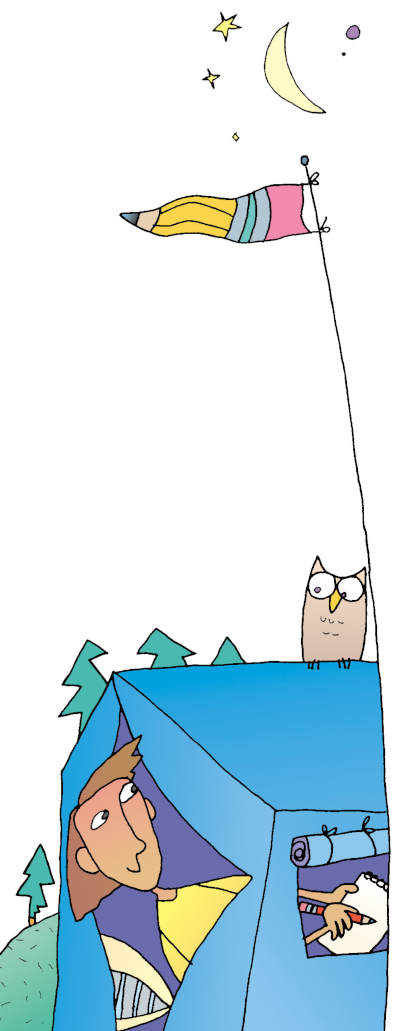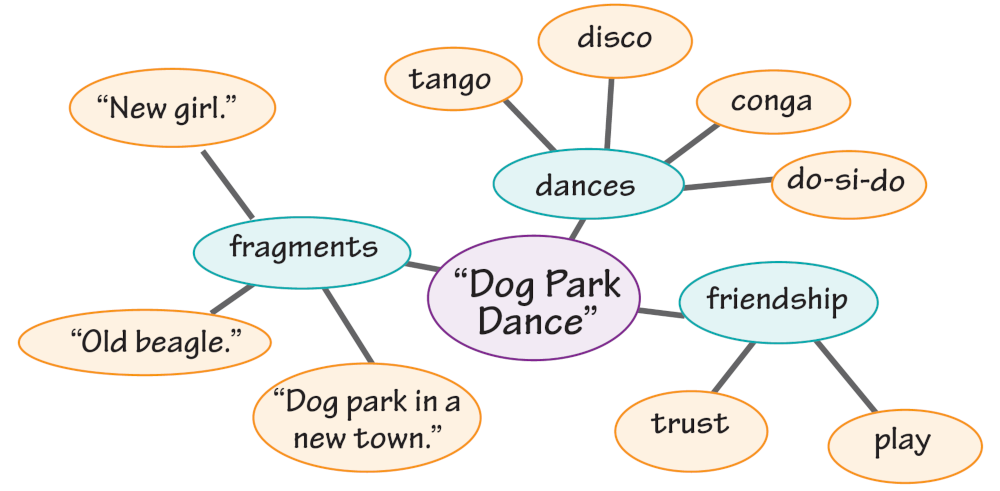
Page 231
Writing About Literature
It’s one thing to think about nature. It’s another thing to immerse yourself in it.
Wind whiffles the nylon tent, bringing the sharp sweetness of pine. Squirrels argue in nearby treetops and scuttle around the trunks. A frog gargles in a stony brook. Something sits on the tent peak, casting a blobby shadow with clutching little claws.
“Who’s that?” you ask breathlessly. Something replies, “Whooo?”
When you write about literature, you need to camp out in a story or poem. Live in it. Breathe it. Enter the world of the literature and exist there for a while. Then write, telling others what it is like to be there!
What’s Ahead
WE 232
Page 232
Sample Essay About Literature
In the following model, student Dave Burling writes about a poem. (See page 288.) He discusses what happens in the poem and the way the writer makes meaning. Specific details support his analysis.
Old Dog, New Trick
Beginning
The writer introduces the poem, sets the scene, and delivers his focus statement. “Dog Park Dance” tells what happens when a girl and her old beagle show up at a dog park in a new town. The girl is nervous about being a stranger. She fears rejection. Her dog, Pepper, doesn’t have any such fears. The poem shows the messy and goofy way that dogs and their people make friends.
Middle
He shares details to support his focus. At first, the girl is closed off. The poet shows this with short sentence fragments: “New girl. Old beagle. / Dog park in a new town.” The poet compares the girl and her dog to a pair of hungry eagles staring down. If it were up to the girl, they’d never get off the bench.
Pepper has other ideas. He wants to meet other dogs, and the girl reluctantly lets him off the leash. He runs to a big German shepherd and the dance begins: tango, disco, conga, do-si-do. Dogs circle and sniff and get to know each other.
People do a similar dance. Ainslie, the owner of the German shepherd approaches. She wonders if she and the new girl might be friends.
Ending
The final paragraph explains a theme of the poem. The poem shows that sometimes the best way to make friends is to go with the flow—do what comes naturally. Circle, sniff, dance, and play. Pepper may be an old dog, but he teaches his owner a new trick.
WE 233
Page 233
Writing a Literature Essay
Here is a sample assignment for writing about literature: Write an essay reflecting on a story or a poem you have recently read. In your essay, (1) focus on a theme in the literature and (2) explain how the writing presents that theme.
Use the PAST strategy to help you understand the assignment better.
- Purpose: To explain a theme of the literature
- Audience: My teacher and classmates
- Subject: A story or poem
- Type: An essay
Prewriting Planning Your Essay
Find a Topic 🟪 To start, choose a story or poem that interests you. Reread the piece. If it is short, reread all of it; if it is long, reread the section you feel strongest about. As you read, make observations and take notes. Answer questions like these: What is awesome about this story or poem? What makes me smile? What is really interesting?
Collect Details 🟪 Make a cluster or list ideas from the story or poem. Write down whatever interests you—favorite characters, special words, images, surprises. Then study your observations. They will lead you to your own idea for the writing.
Sample Cluster

WE 234
Page 234
Possible writing idea from the cluster:
At first, everything is stuck. Fragments. No verbs. Then it’s all verbs. It dances. Making friends is about getting active. Doing.
Sample List
• The girl is afraid of rejection. She doesn’t think anyone will like her or her old dog.
• Pepper is excited and wants to get out there. He’s old, but he’s hopeful: “I want to meet you!”
• The girl says, “Don’t you know that dog will eat you?”
• She lets Pepper off his leash, and he charges a German shepherd.
• Is it a disaster, or just a dance? You don’t know until it happens.
• To make a friend, you have to take a risk and hope for the best.
• An eager old dog can help you.
Possible writing idea from the list:
To make a friend, you have to take a risk and hope for the best. Try it and see what happens.
Write Your Main Idea 🟪 After clustering or listing your observations, choose a writing idea. This will be the main idea of your essay. Refine it by asking these questions: Is this what I want to say? Can I say it better? Then rewrite your idea until you are satisfied with it.
Original Idea
To make a new friend, you’ve got to stop worrying and instead get moving. Have some fun!
First Revised Idea
This poem shows that you’ve just got to take a risk and start that dance if you want to make a new friend.
Second Revised Idea
The poem shows the messy and goofy way that dogs and their people make friends.
WE 235
Page 235
Writing Developing the First Draft
Beginning 🟪 In the first paragraph, do two things:
Name the title of the story or poem.
Share your main idea—your opinion or explanation.
“Dog Park Dance” tells what happens when a girl and her old beagle show up at a dog park in a new town. The girl is nervous about being a stranger. She fears rejection. Her dog, Pepper, doesn’t have any such fears. The poem shows the messy and goofy way that dogs and their people make friends.
Middle 🟪 In the middle paragraphs, support your main idea. Use the details you collected (cluster, list). Look over the text again to find even more information.
Include the best details to explain your main idea.
Include exact words (quotations) to make your point.
At first, the girl is closed off. The poet shows this with short sentence fragments: “New girl. Old beagle. / Dog park in a new town.” The poet compares the girl and her dog to a pair of hungry eagles staring down. If it were up to the girl, they’d never get off the bench. . . .”
Ending 🟪 In the last paragraph, make a final comment about the writing. Here are some ideas:
Repeat your main idea.
Tell how a character has changed.
Include an idea that makes the reader think.
The poem shows that sometimes the best way to make friends is to go with the flow—do what comes naturally. Circle, sniff, dance, and play. Pepper may be an old dog, but he teaches his owner a new trick.
WE 236
Page 236
Revising Improving Your Writing
Review your first draft by asking the questions on this checklist. Then make any needed changes.
_____ Does my essay have a beginning, a middle, and an ending?
_____ Does the first paragraph include the title and author? Does it give my main idea?
_____ Do the middle paragraphs include details from the piece of writing?
_____ Does the last paragraph repeat the main idea and end the essay effectively?
Editing and Proofreading Checking for Errors
Then check your revised writing for spelling, grammar, and punctuation errors. (See the “Editing and Proofreading Checklist” on page 66.)
Publishing Sharing Your Work
When you’ve finished editing and proofreading your essay, make a neat final copy to share. You might share it by reading it aloud to the class, posting it on the classroom blog, or pinning it to the bulletin board. Your teacher may have suggestions as well.